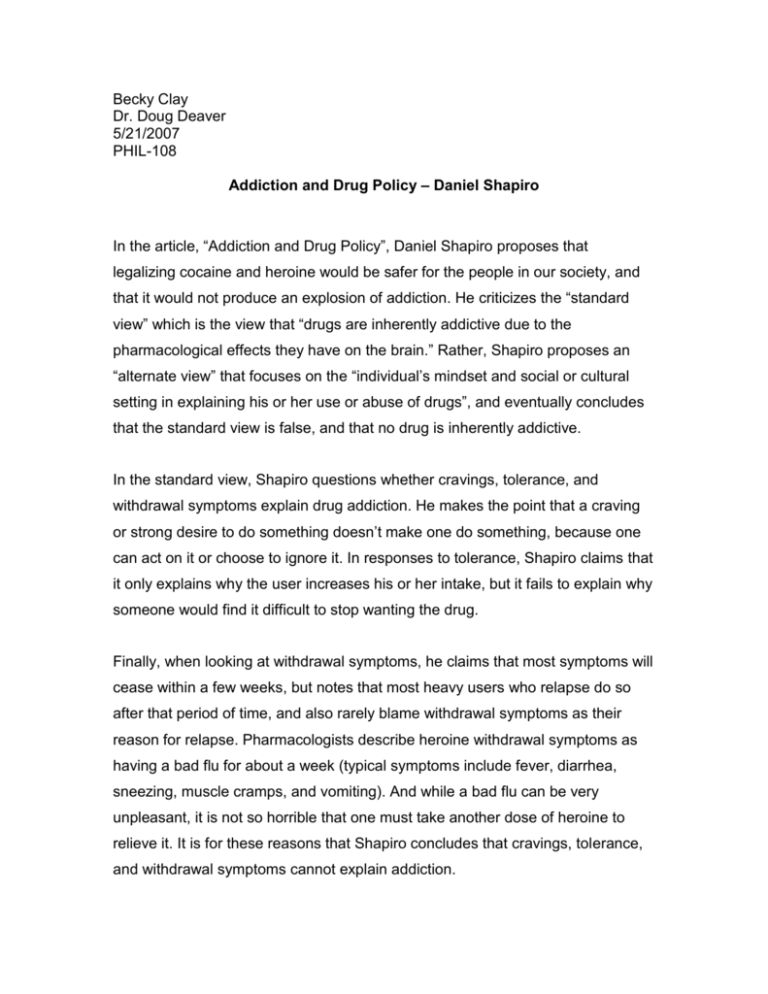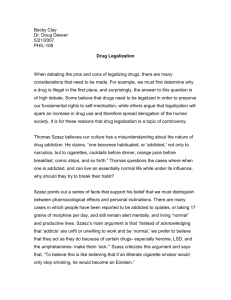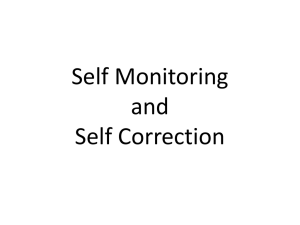AddictionDrugPolicy.doc
advertisement

Becky Clay Dr. Doug Deaver 5/21/2007 PHIL-108 Addiction and Drug Policy – Daniel Shapiro In the article, “Addiction and Drug Policy”, Daniel Shapiro proposes that legalizing cocaine and heroine would be safer for the people in our society, and that it would not produce an explosion of addiction. He criticizes the “standard view” which is the view that “drugs are inherently addictive due to the pharmacological effects they have on the brain.” Rather, Shapiro proposes an “alternate view” that focuses on the “individual’s mindset and social or cultural setting in explaining his or her use or abuse of drugs”, and eventually concludes that the standard view is false, and that no drug is inherently addictive. In the standard view, Shapiro questions whether cravings, tolerance, and withdrawal symptoms explain drug addiction. He makes the point that a craving or strong desire to do something doesn’t make one do something, because one can act on it or choose to ignore it. In responses to tolerance, Shapiro claims that it only explains why the user increases his or her intake, but it fails to explain why someone would find it difficult to stop wanting the drug. Finally, when looking at withdrawal symptoms, he claims that most symptoms will cease within a few weeks, but notes that most heavy users who relapse do so after that period of time, and also rarely blame withdrawal symptoms as their reason for relapse. Pharmacologists describe heroine withdrawal symptoms as having a bad flu for about a week (typical symptoms include fever, diarrhea, sneezing, muscle cramps, and vomiting). And while a bad flu can be very unpleasant, it is not so horrible that one must take another dose of heroine to relieve it. It is for these reasons that Shapiro concludes that cravings, tolerance, and withdrawal symptoms cannot explain addiction. Another main argument that Shapiro points out is that most drug users, whether they use legal or illegal drugs, do not become addicts, and few so remain so permanently (excluding cigarette smokers). For example, surveys conducted by the Substance Abuse and Mental Health Services Administration found that less than ten percent of those who have tried cocaine use it monthly. Even still, less than ten percent of monthly cocaine users used it daily. These statistics are slightly higher, but very close to, those of crack cocaine and heroine. These studies have been conducted over a set of users over time, and indicate that the moderate use of these drugs is the norm and is not so much exceptional cases. These studies also prove that even the heaviest of users do not inevitably march to addiction, let alone remain permanent addicts. In his alternate view, Shapiro proposes that “how one interprets or understands the experience depends on one’s individuality and the cultural or social setting” and it is this process, which makes an addict, not the drugs themselves. He defends a view of addiction, summed up by Norman Zinberg, Drug, Set, and Setting (1984). The word “drug” means pharmacology, “set” refers to the person’s mindset, personality, values, and expectations, and “setting” refers to the cultural or social surroundings of drug use. Shapiro claims “what results from drug use depends not just on the experience or effects produced by the drug but also on the interpretation of that experience or effects.” Beginning with setting, Shapiro uses the example of hospital patients that get continuous and massive doses of narcotics, yet rarely get addicted or even crave these drugs after release from the hospital. In another example, Shapiro mentions, “three-quarters of Vietnam vets who used heroine in Vietnam became addicted, but after coming home, only half of the heroine users in Vietnam continued to use, and of those only 12 percent were addicts.” These same results are found when considering the effects of alcohol in different cultures. Shapiro points out that in Finland, violence and alcohol are linked, but in Greece, Italy, and other Mediterranean countries, where drinking is moderately controlled, there is no violence- alcohol link. Shapiro explains this difference by explaining that “humans are social or cultural animals, not just products of their biochemistry, and this means, in part, that social norms or rules play a significant role in influencing behavior.” Basically, his argument here is that in cultures where drugs such as alcohol are viewed as accompaniments to life, that moderate and controlled use will be the norm. This explains that though in these Mediterranean cultures there is typically a larger rate of alcohol consumption, there is still very few cases of alcoholism. The usage is controlled and moderate. When evaluating the effects of “set” on drug use (the mindset, values, personality, and expectations), expectations prove to be the most significant. Expectations are important because drug use occurs in a pattern of ongoing activity, and “one’s interpretation of the drug’s effects depends upon expectations of how those effects will fit into or alter those activities.” For example, when experiments were performed on American college-aged men, aggression and sexual arousal increased when the men were told they were drinking alcohol when in fact they were drinking zero proof. On the opposite, when the men were told they were drinking zero proof and were in fact drinking alcohol, their sexual arousal and aggressiveness remained at average levels. Shapiro uses this experiment to conclude “those who view (drugs) as an enhancement or a compliment to certain experiences or activities will tend not to let drugs dominate or overpower their other interests.” When examining the “drug” aspect of drug use, or better referred to as the “pharmacology” role, Shapiro is able to explain why quitting smoking is much harder than it is to stop using other substances. He begins this argument by stating that smokers smoke to relax, concentrate, handle anxiety, stress, difficult interpersonal situations, and also as a means of oral gratification and a social lubricant… and these are just to name a few. Because smoking is a part of so many activities, situations, and moods, quitting smoking often means a major change in one’s life. Shapiro explains that because of these facts, the pharmacology of smoking cannot be separated from its social setting. Because the nicotine in cigarettes has mild pharmacological effects, it has become easily and well integrated into smoker’s lives. To give an example, Shapiro exposes the preference of low tar/nicotine cigarettes, wine, and beer over hard liquor. Shapiro also acknowledges that pharmacology coincides with “set” as well (again, “set” is the individual’s mindset, personality, values, and expectations). Because the harms of smoking are slow to occur, they do not affect the person’s ability to perform normal activities (at least until they are seriously ill). Therefore, eliminating these harms requires one to completely quit smoking, not just cut back, because it is proven that even light smokers increase their chances of lung cancer, heart disease, emphysema, etc. Most of what Shapiro is arguing seems to make good, logical sense. There are many cases where people are in hospitals receiving high doses of drugs and very rarely ever become addicted. Sure, there are the cases where patients do become dependent on these drugs, but when compared to the amount of people who are admitted to hospitals and are administered these drugs, it is safe to say that number of addicts under these pretences are pretty insignificant. The argument Shapiro makes for the drug, set, and setting seems to support these claims as well. Recalling the experience one received from a drug while in the hospital is far different from recalling an experience at a club with some friends. A stay in the hospital would in most cases be far less pleasurable than an experience remembered at a party when the drug was used to enhance an already good setting. By realizing the differences of addicted smokers versus addicts of cocaine and heroine, Shapiro believes that we can conclude that heroine and cocaine are not inherently addictive, and that the addictiveness of any drug depends on the three views of addiction, set, setting, and pharmacology. The highly addictiveness of cigarettes can be attributed to the fact that the set and setting of the drug, and how easily it is integrated into peoples lives. Shapiro concludes that “The desire of most people to lead responsible and productive lives in a social setting that rewards such desires is what controls and limits most drug use.”










